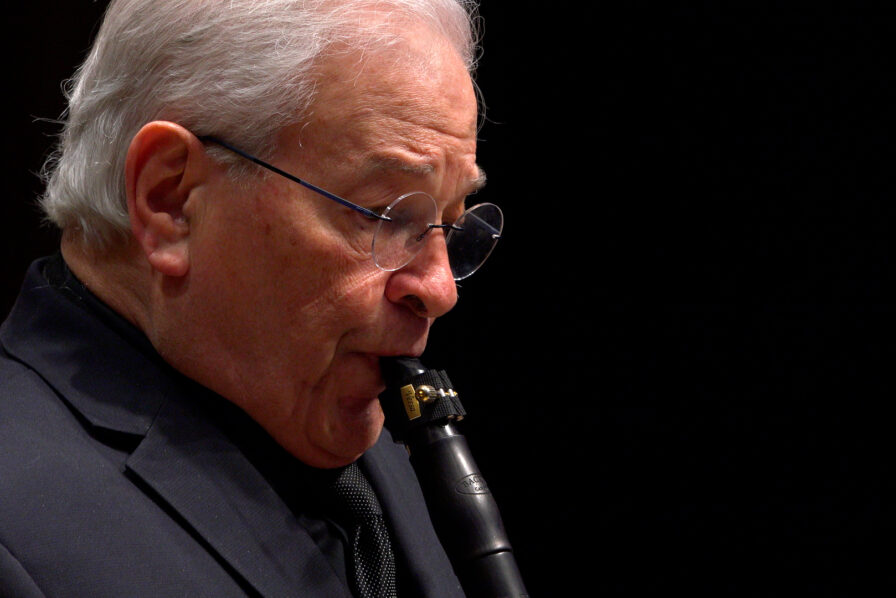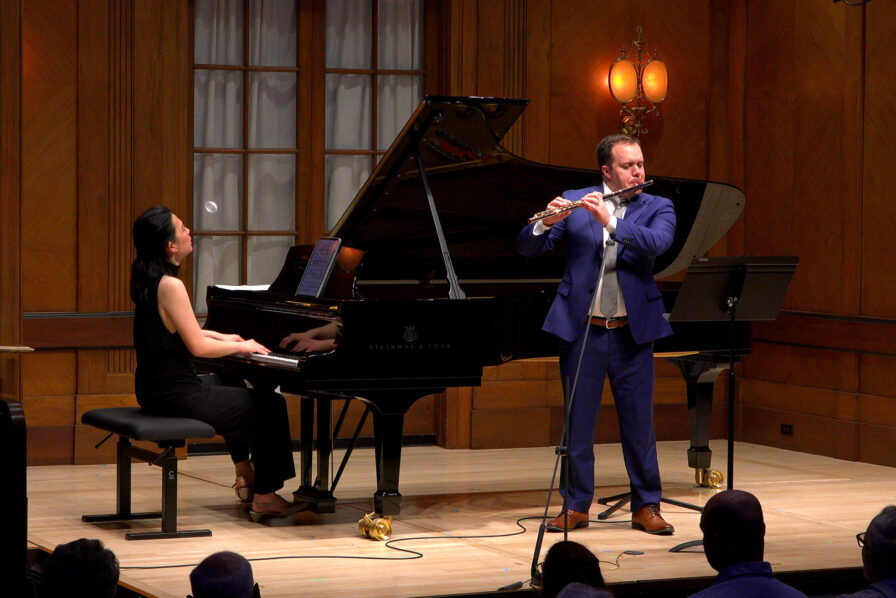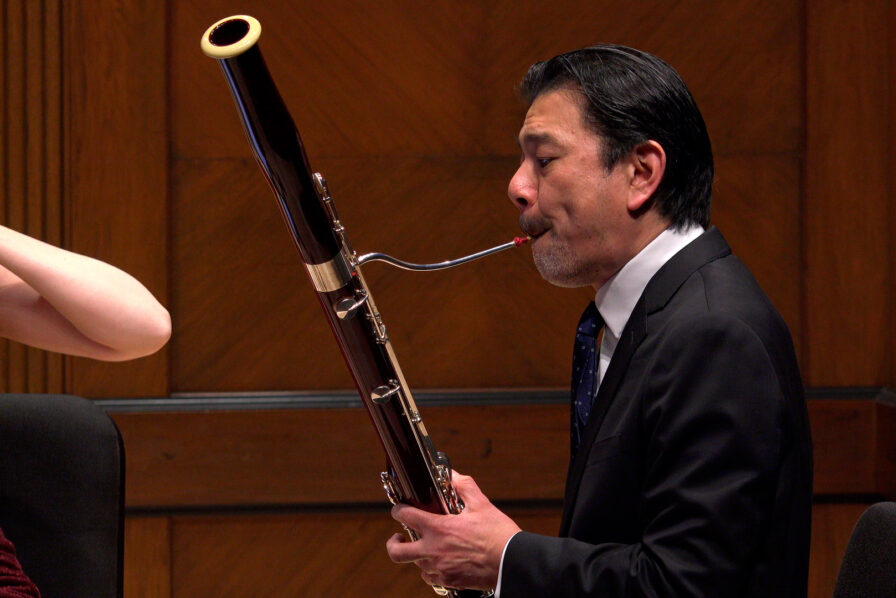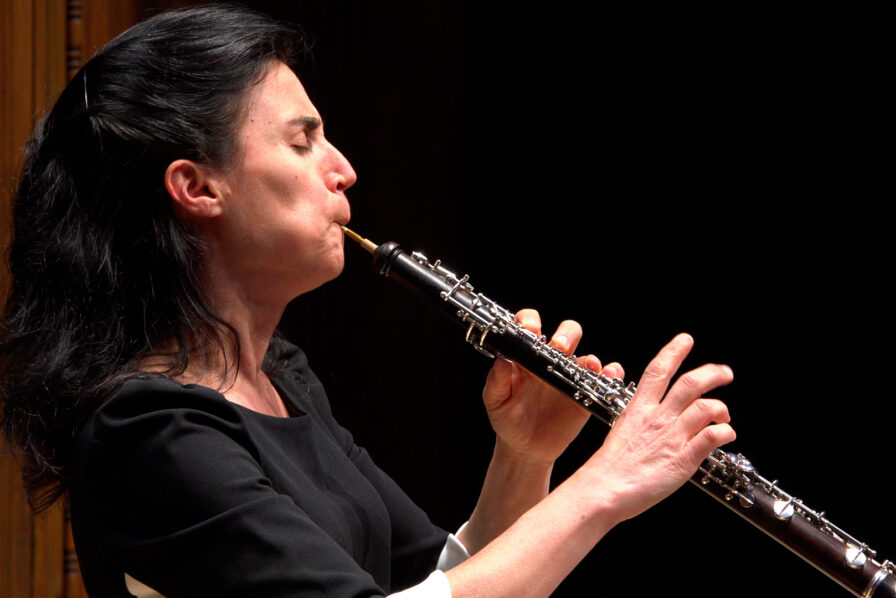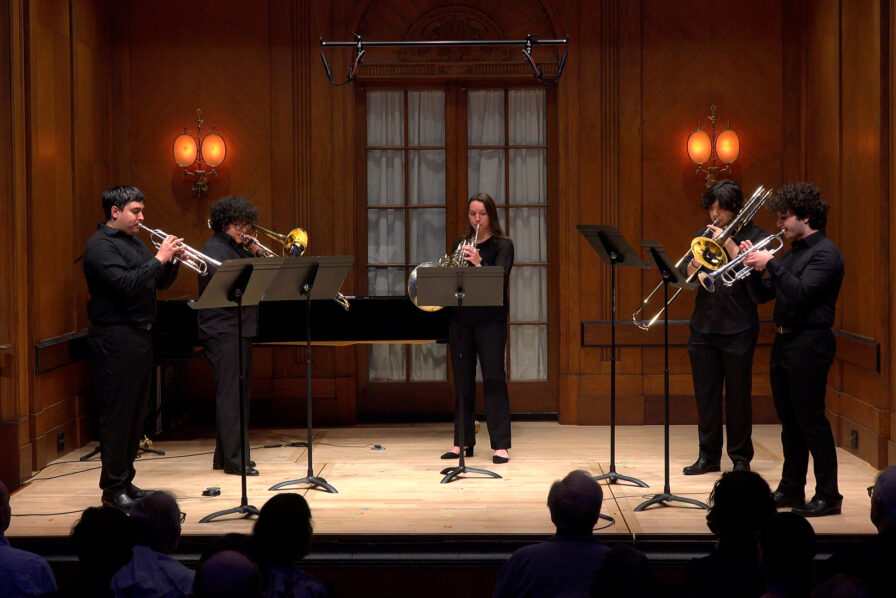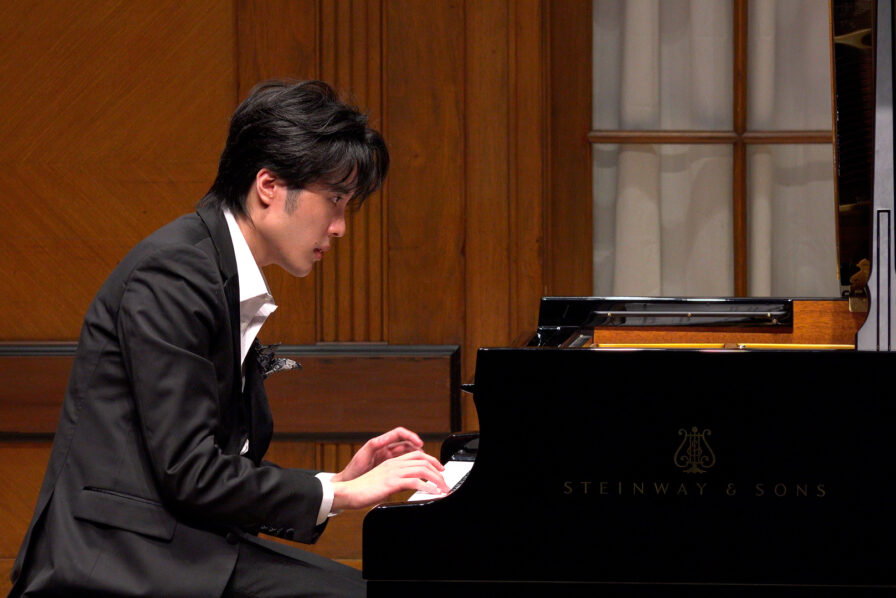A Century of New Sounds

Chamber works of Barber, Bernstein, Eastman, Higdon, Holland, Ludwig, Rorem, Smith, Walker.
A Century of New Sounds celebrates the 100th Anniversary of Curtis Institute of Music through the artistry and innovation of performances by alumni, faculty, and students. The selection of chamber music, recorded on the school’s historic campus in Philadelphia, presents a range of musical styles and ideas from Curtis composers past and present.
About

New music has been central to Curtis’ story since the school first opened its doors. From the time of Samuel Barber (’34), Ned Rorem (’44), and George Walker (’45) through to the present day, Curtis composers have made lasting contributions to the living tradition of classical music. As Curtis turns 100, A Century of New Sounds celebrates the music of Curtis composers across time. Works by early Curtis titans like Barber, Rorem, Walker, and Bernstein (’41) are heard here alongside music by longtime faculty members Jennifer Higdon (’88) and David Serkin Ludwig (’01), current faculty member Jonathan Bailey Holland (’96), and Curtis alum Gabriella Smith (’13). The album also champions a previously unpublished work by Julius Eastman (’63), licensed and arranged by Elijah Daniel Smith, Curtis’ manager of new music activities, specifically for this recording.
This small but impactful group of composers, heard together, offers listeners a sonic taste of the many distinct musical voices that have emerged from Curtis. The combined efforts of these composers represent a deep commitment to the future of our art form and a blend of tradition and innovation that is a hallmark of the Curtis approach. Whether articulated on strings, winds, brass, percussion, or keyboards, as performed by Curtis faculty, alumni, or current students, this music is a testament to the quality, expressivity, and individuality of Curtis composers.
—Nick DiBerardino (Composition ’18), chair of composition studies
Tracklist & Notes
-
LEONARD BERNSTEIN: Sonata for Clarinet and Piano
I. Grazioso
II. Andantino – Vivace e leggieroDavid Shifrin (Clarinet ’73)
Amy Yang (Piano ’06), facultyThis Sonata by Leonard Bernstein was his first published piece, completed in 1941 about the same time he was graduating from Curtis—perhaps maybe even invented some in this room [Field Concert Hall].
In the summer after he graduated, Bernstein attended the Tanglewood Music Festival, an event he would continue to do nearly every summer up until his passing in 1990. It is here where the bulk of this sonata was composed, being greatly influenced by his contemporaries, Paul Hindemith, Aaron Copland, and very much by his close friend, David Oppenheim—the clarinetist for whom the piece was written and subsequently recorded.
Packing so much material into the piece, it may come as a surprise that it only lasts 10 minutes. A plethora of mood changes and stylistic transitions can be heard throughout that might even be recognizable from some of his more popular later works, most clearly West Side Story. The rhythmic complexity, mixed meters, and jazz inflections alone are astounding, all packed into two short movements.
—David Shifrin (Clarinet ’73)
-
SAMUEL BARBER: Canzone (Elegy) for Flute and Piano, Op. 38a
Patrick Williams (Flute’14)
Amy Yang (Piano ’06), facultyCelebrating Curtis’ longstanding tradition of groundbreaking artistry, we are thrilled to share a composition from the pen of a beloved Curtis composer, Samuel Barber.
The archives reveal that Barber’s commitment to composing was nurtured by the founder of Curtis, Mary Louise Curtis Bok, with whom Barber exchanged a long and affectionate correspondence, even after graduation. The artistic resolution of this West Chester, Pennsylvania, native was in evidence even earlier when, in 1919, Barber wrote to his mother:
“I was meant to be a composer and will be I’m sure…don’t ask me to try to forget this unpleasant thing and go play football—please….”
That nine-year-old’s sweet and adamant voice echoes today as we trace the path that brought him, five years later, here to Curtis, honing his voice in composition, voice, and piano for the next ten years—later to establish an illustrious career as one of the most important voices in 20th century American music.Canzone (Elegy) was written in 1959 for solo flute with the piano part coming later. In 1962, Barber re-contextualized the piece as the second movement of his piano concerto, which won him his second Pulitzer Prize.
Given that two thirds of Barber’s output was vocal music—Sure on this Shining Night, Dover Beach, Hermit Songs, and Knoxville: Summer of 1915—I think we might consider this canzone as a song without words. The flute and piano parts share a DNA of dissonances, the resolutions are bittersweet and haunting.
In this music, we reflect on a life devoted to the musical arts. This song finds its place to sing, in celebration, back home on this centenary album, with a matured assurance of someone whose musical gifts continue to break ground and inspire.
—Amy Yang, associate dean of piano studies & artistic initiatives
-
JENNIFER HIGDON: Autumn Music for Woodwind Quintet
Imani Winds, faculty
When I started thinking about writing a piece for woodwind quintet, my mind began to contemplate all of the wonderful chamber music that I have played as a flutist through the years. My mind kept going back to one of the greatest contributions to the woodwind quintet literature, Samuel Barber’s Summer Music. Having the privilege, as I do, of having been a student and now a teacher at the same school where Mr. Barber was both, I am ever aware of the gratitude and esteem with which I hold this artist who created so much beautiful music. It is with a humble heart that I pay homage to him and to the genre of woodwind quintet literature with this piece.
Autumn comes to us in many guises: incredible explosions of color; air that suddenly snaps with crispness and clarity; a tinge of melancholy on the eve of change in all of our lives. This piece is a musical portrait of the essence and images of Autumn.
The first part of the quintet represents the beginning of the season, with its explosions of color, sharp lines, and vivid imagery; always changing and always vibrant. The musical lines are sometimes present with each instrument carrying a different rhythm, reminiscent of the way leaves float down from a tree in a very unsynchronized manner. As the quintet moves into the last part of the work, there is more of an introspective and melancholy quality to the music; the music itself becomes more simplified, with a darker color to the sound. It is the passing of the season.
—Jennifer Higdon (Composition ’88), former faculty
-
DAVID SERKIN LUDWIG: Three Pictures from the Floating World
I. Voiles
II. Sirens
III. OndineDaniel Matsukawa (Bassoon ’92), faculty
Emmalena Huning, violin, student
Sumin Kim, viola, student
Ania Lewis, cello, studentThree Pictures from the Floating World, composed by David Serkin Ludwig, comes from an actual concerto for bassoon and orchestra called Pictures from the Floating World. This was commissioned, premiered, and written for Yannick Nézet-Séguin of the Philadelphia Orchestra, and myself [Daniel Matsukawa]. The premiere was well received, and it was later performed by other great bassoonists and orchestras—most notably Catherin Van Handel (Bassoon ’15) with the Milwaukee Symphony Orchestra, William Short (Bassoon ’10) of the Met Opera Orchestra, and Nancy Goeres of the Pittsburgh Symphony Orchestra.
A few years after the premiere, I asked David if he could please create a version for bassoon and string trio. This version was originally composed for the Philadelphia Chamber Music Society and compositionally speaking, is a phenomenal adaptation of the original work.
When David first started composing this work, he told me he was thinking a lot about bassoon fluidity and the interaction of Japanese art with French composers, more specifically, Debussy. Being very interested in instances where cultures overlap and connect, he was yearning to find the connection between myself and Yannick within the language we both shared.
At the turn of the 20th century, you may know that Debussy was also inspired by Japanese art. At the 1867 World’s Fair in Paris, he came across these beautiful Japanese wood prints by Katsushika Hokusai. The most famous of these being The Great Wave Off Kanagawa, which was featured on the cover of Debussy’s La Mer (The Sea).
Each of these three “pictures” is a direct reflection on Debussy’s own piano music, specifically his pieces connected to water. This is most easily heard through David’s use of elongated melodies and singing legatos.
Movement one comes directly from Debussy’s Voiles, meaning veils or sails and can be thought of as an undulation in the sea breeze. Sirens, the second movement, refers to the singing harpies that try to lure sailors away with their mesmerizing singing. And the final movement, Ondine, is an elemental spirit made of water, who only gains a soul after being married to a human.
—Daniel Matsukawa (Bassoon ’92), faculty
-
NED ROREM: Mountain Song for Oboe and Piano
Katherine Needleman (Oboe ’99), faculty
Natalie Zhu (Piano ’97)Most people know of Ned Rorem for his abundant art song compositions; however, he was equally adept at writing for instrumental forces. Winning the Pulitzer Prize in 1976 for his orchestral piece Air Music, he has amounted a vast repertoire of instrumental works.
This particular piece, Mountain Song, was originally written for flute and piano, and was Rorem’s first real work for the instrument. As a student of Rorem, I found that he enjoyed writing in witty ways, with him saying in his note for this piece that he had a “hunger for the flute long before I was aware that oboes and clarinets and bassoons were also individuals”.
Composed in 1949, the piece was written as background music for a play by British writer, Iris Tree, set in rural Kentucky. In true Rorem style, he paraphrased a “half-remembered” southern folksong, so even though there is no voice, it is still remotely in a song form. Rorem himself even stated “I conceive all music…vocally. Whatever my music is written for—tuba, tambourine, tubular bells—it is always the singer within me crying to get out.”
You will note that he was very good at paring down his material. The flute, in this case oboe, has its lyrical, vocal-like melodies throughout the piece; but it is the piano, and really the harmony, that actually drives the music throughout.
—Jonathan Bailey Holland (Composition ’96), faculty
-
GEORGE WALKER: String Quartet No. 1 “Lyric”: II. Molto Adagio
Dover Quartet, faculty
George Walker’s Lyric for Strings has become the composer’s most visited work and a cornerstone of mid-century lyricism in string writing. Walker, who in 1996 became the first African American to receive a Pulitzer Prize in Music, wrote the piece when only 19 years old and still a student at Curtis. Incredibly by this time, the talented pianist and composer had already graduated from Oberlin Conservatory, where he began his studies at 14.
Lyric is often compared to Samuel Barber’s famous Adagio for Strings and for good reason: both were originally slow movements of a string quartet (later expanded for string orchestra) in which their reach and renown spread tremendously; both painful, yet cathartic; and finally, both composers studied with the same composition teacher, Rosario Scalero, at Curtis.
As a performer, what strikes me about this work is that while it has universal relatability, it was a process of catharsis for Walker to write as he navigated feelings of loss. Dedicated to his grandmother Melvina King, a former slave who died during his work on the beginnings of the quartet, the original title was Lament. The work mourns the loss of a person very close to him, yet offers peace, acceptance, and reverence. All of this is conveyed in an unfettered directness that speaks to his immense artistry. It is a magical work to perform live, transfixing the audience in a kind of spell that is difficult to compare.
—Camden Shaw (Cello ’10, ’11, String Quartet ’14), Dover Quartet, Penelope P. Watkins Ensemble in Residence
-
JONATHAN BAILEY HOLLAND: Introit for Brass Quintet
Dasara Beta, trumpet, student
Justin Bernardi (Trumpet ’24)
Kristin Andlauer, horn, student
Diogo Fernandes (Trombone, ’24)
Noah Urquidi, bass trombone, studentWritten while I was a student at Curtis in the mid-nineties, Introit for Brass Quintet is a jaunty, short celebratory invocation in triple meter. An introit, like a fanfare, is music that is meant to mark the beginning of a special occasion or event.
I was a trumpet player well before I was a composer, and brass quintets and fanfares were very familiar to me, so I was happy to compose this work for my friends and classmate at the time. Now on faculty here, I am happy to be rejoined with one of the members of that student brass quintet, Paul Bryan (Trombone ’93), former dean of Curtis, and current director of assessment and accreditation.
—Jonathan Bailey Holland
-
JULIUS EASTMAN: Four Pieces for Piano, transcr. Elijah Daniel Smith
Piano Piece I
Piano Piece II
Piano Piece III
Piano Piece IVJiacheng Xiong (Piano ’20)
Eastman as a musician was many different things. He was a composer (in the traditional sense), pianist, vocalist, improviser, and somewhat of a performance artist. Being truly a singularity in music however, also meant that his art was notoriously difficult to replicate. Much of what was performed by himself and his collaborators was not written down; and what was written down was often left deliberately vague, open-ended, or freely improvised to allow play with the material.
These four miniatures originate from a recorded performance Eastman gave at an “Evenings for New Music” event on December 15th, 1968, at the Albright-Knox Art Gallery (now known as The Buffalo AKG Art Museum) in Buffalo, New York. Until recently, these pieces had only ever been transcribed once before for a London Symphony Orchestra showcase concert in June of 2023.
As the transcriber, there are a lot of difficulties in notating music like this. Seeing as we only knew that these pieces existed from a rough recording, the source materials contain a lot of abnormalities. At first hearing, you may think this is just extraneous noise from things going on in the room—that is until you listen closely and realize that it is actually Eastman himself deliberately making bodily effects. It may sound crazy, but is also something that only Eastman could present and brilliantly make work with his music.
These archive recordings come courtesy of the University at Buffalo’s Archives, with permission from G. Schirmer, Inc.
—Elijah Daniel Smith, composition and New Music Ensemble associate
-
GABRIELLA SMITH: Anthozoa for Violin, Cello, Piano, and Percussion
Maya Anjali Buchanan (Violin ’24)
Matthew Christakos (Cello ’24)
Delvan Lin, piano, student
Tae McLoughlin (Percussion ’24)Praised by the L.A. Times as an “outright sensation” and deemed “the coolest, most exciting, most inventive new voice I’ve heard in ages” by Musical America, award-winning Curtis alumna and ecological activist Gabriella Smith’s imaginative compositions revel in the exploration of unexpected soundscapes, connecting audiences to nature and sparking joy and change through climate action. Inspired by recordings the composer made while taking a paddleboat out on the reefs of French Polynesia and named after a class of marine invertebrates that include sea anemones and coral, Anthozoa captures the aquatic sounds she found beneath the surface and along the seashell-scattered shoreline.
This hypnotic work features a prepared piano, sliding pizzicato cello, unpitched strikes on the violin, and a lively array of percussive found instruments that evoke the sights and sounds of graceful, flowing fans and hundreds upon thousands of tiny, tentacled polyps swaying about in their coral colonies. As the slinky, clinking, propulsive piece progresses, each musician manipulates their instruments to conjure up brightly colored fish, eels, sharks, sea turtles, and manta rays as they swim in and out of this breathtaking ecosystem. Anthozoa concludes with an eerie passage that hints at the impending destruction of these fragile yet resilient undersea gardens, somehow thriving despite the continued threat of climate change, warming seas, bioerosion, overfishing, and pollution.
Artists
Dover Quartet
Joel Link | Violin
Bryan Lee | Violin
Julianne Lee | Viola
Camdem Shaw | Cello
Imani Winds
Brandon Patrick George | Flute
Toyin Spellman-Diaz | Oboe, English Horn
Mark Dover | Clarinet, Bass Clarinet
Kevin Newton | Horn
Monica Ellis | Bassoon
Kristin Andlauer | Horn
Dasara Beta | Trumpet
Matthew Christakos | Cello
Emmalena Huning | Violin
Ania Lewis | Cello
Daniel Matsukawa | Bassoon
Katherine Needleman | Oboe
Noah Urquidi | Bass Trombone
Jiacheng Xiong | Piano
Natalie Zhu | Piano
Justin Bernardi | Trumpet
Maya Anjali Buchanan | Violin
Diogo Fernandes | Trombone
Sumin Kim | Viola
Delvan Lin | Piano
Tae McLoughlin | Percussion
David Shifrin | Clarinet
Patrick Williams | Flute
Amy Yang | Piano
